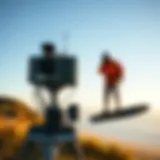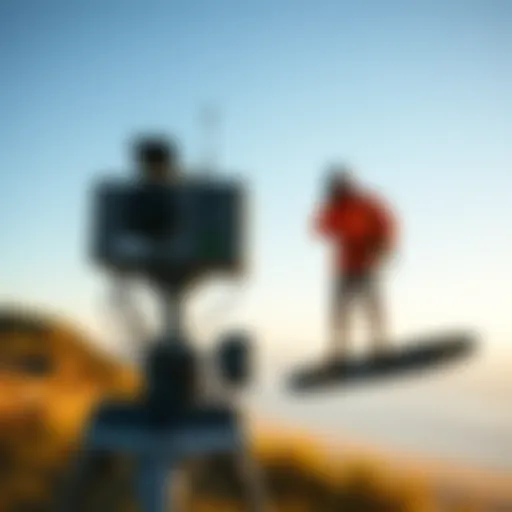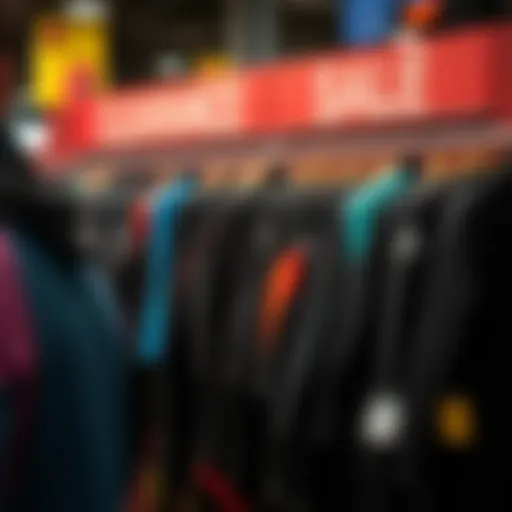In-Depth Analysis of Hover Foil Boards
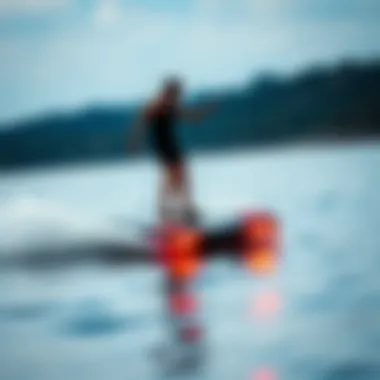
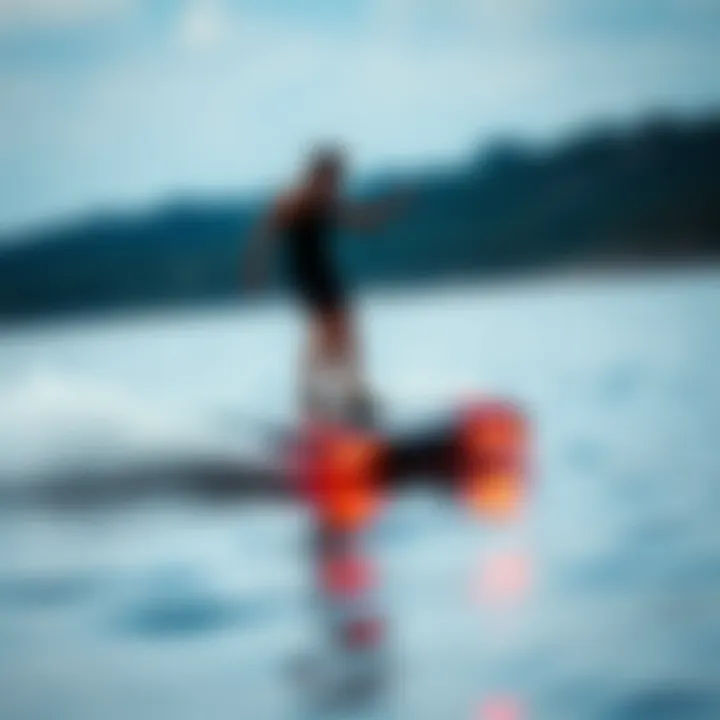
Intro
Kiteboarding enthusiasts have witnessed a fascinating evolution in equipment over the years. Among the innovations taking the community by storm is the hover foil board. These boards allow riders to glide above the water, offering a thrilling sensation that traditional kiteboards cannot quite replicate. This article aims to peel back the layers on hover foil boards, discussing their design, features, and functionality while considering their role in enhancing rider experience.
As the sport gains popularity, understanding the mechanics of these boards becomes essential—not just for seasoned riders but also for newcomers looking to make waves. So, grab your gear and let's dive into the world of hover foiling, exploring the technology that elevates riding to an exhilarating new level.
Gear Insights
The choice of gear can make or break a kiteboarding experience, particularly with hover foil boards. Investigating the latest offerings is crucial for both novice and experienced riders to keep their skill progression and enjoyment in check.
Latest Gear Reviews
When it comes to options, it's hard to ignore brands like Slingshot and Naish, which continually bring out new models that look promising. The Slingshot Hover Glide has intrigued many with its user-friendly design and impressive stability. Riders extol its ability to offer a smooth ride, making it a solid choice for those wanting to step into the foil world alongside aesthetics that speak volumes.
On the other hand, Naish's Hover Series boasts high performance and cutting-edge technology, allowing for quick maneuvers and heightened control. These boards are designed to withstand rough sea conditions and adapt well to various water sports, from surfing to kiteboarding, highlighting their versatility. In addition to these, smaller brands like Lift Foils have begun to create stirrings in the niche with their premium boards that emphasize lightweight materials and efficiency in performance.
Key features to consider when purchasing:
- Material Durability: Should withstand tough conditions and impacts.
- Weight: Lighter boards generally enhance performance and maneuverability.
- Size: The board size affects stability and lift, impacting the overall experience depending on conditions.
Essential Gear for Beginners
For newcomers, starting with the basics can seem overwhelming. However, understanding the core elements can pave the way for a smoother entry. Selecting proper safety gear like a helmet and impact vest is imperative, as safety should always be the top priority. Additionally, a well-fitted harness is key to ensuring that all rider movements translate seamlessly to the board.
Moreover, one might consider attending lessons from certified instructors. Not only will this equip beginners with essential skills, but it also builds a solid foundation in safe practices. Matching the right board with appropriate kite sizes based on wind conditions will further enhance learning without endangering personal safety.
Techniques and Tips
Once you've got your gear sorted and have taken your first rides, the focus shifts to honing techniques and ensuring safety while having fun.
Advanced Tricks and Techniques
For those ready to elevate their gameplay, mastering various tricks will be the next logical step. Riders often start off with the jibe, a turn that allows them to change direction while maintaining momentum. Once comfortable, they can transition into more complex maneuvers like the backflip or even spins by properly timing kite control and body positioning.
Incorporating techniques like these not only adds flair but also significantly increases the thrill factor for both rider and observer alike. Remember, practice breeds consistency—don't hesitate to experiment while also respecting your limits.
Safety Practices for Kiteboarders
With all the excitement racing through your veins, it’s essential not to overlook safety while kiteboarding. Here are a few tips:
- Stay Alert: Always watch for obstacles in the water or other riders.
- Know Your Environment: Check wind and weather conditions before heading out to avoid sudden changes that can affect your ride.
- Use a Buddy System: Riding with someone else ensures that you're never alone in case of an emergency.
- Regular Gear Check: Inspecting equipment for wear and tear can prevent accidents.
"Safety first! Always ensure your gear is in top shape before hitting the waves—no one enjoys a nasty surprise out at sea."
Prelims to Hover Foil Boards
In recent years, hover foils have made quite a splash in the watersport community, especially among kiteboarders. These boards have redefined the experience of gliding over water, providing a thrilling sensation that many enthusiasts seek. Understanding what hover foil boards are, their evolution, and their unique attributes is essential for anyone looking to delve into this exhilarating sport.
Hover foils utilize principles of aerodynamics and hydrodynamics to lift above the water's surface. This allows the rider to smooth out the chop, achieving a level of gracefulness not experienced on traditional boards. The silent gliding above the waves creates an almost surreal experience, appealing to both seasoned kiteboarders and those new to the sport.
Defining Hover Foil Boards
At their core, hover foil boards comprise a board and a hydrofoil. The hydrofoil is an underwater structure that extends below the board, featuring wings that lift the board out of the water as it gains speed. This design minimizes drag and enhances stability, enabling riders to experience new levels of performance. Hover foil boards may vary in size and shape but generally aim to achieve the same goal: riding above the water.
Hover foils have gained traction not just for their performance but also for their versatility. They are designed for various water conditions, from flat lakes to ocean swells. Many riders appreciate this adaptability since it allows for a range of riding styles from leisurely cruising to high-speed racing.
Historical Context and Evolution
The journey of hover foiling began with innovations in water sports equipment. While the concept of foiling traces back decades, it started catching mainstream attention in the early 2000s with advancements in board manufacturing and aerodynamics. The fusion of kiteboarding with foiling provided a breakthrough; it wasn't long before enthusiasts began experimenting with different designs to push the limits of these boards.
Initially, foils were bulky and complex, making them challenging for novice riders. However, as technology progressed, manufacturers refined the designs, focusing on lighter materials and user-friendly configurations. Riders now have access to a wide array of options suited for all skill levels, enhancing the overall accessibility of this thrilling sport.
In this context, it's important to mention that the birth of hover foiling coincided with rising environmental concerns, leading manufacturers to explore sustainable materials. This focus on eco-friendly practices is attracting a new generation of eco-conscious riders, further propelling the sport's popularity.
Hover foiling, a blend of tradition and innovation, has rapidly redefined kiteboarding. As we explore the mechanics and various aspects surrounding hover foil boards, it becomes clear that they offer much more than just a ride; they serve as a pathway into the evolving realm of watersports.
Understanding the Mechanics of Foiling
When delving into the world of hover foil boards, grasping the mechanics of foiling is not only essential, but it also shapes the way riders experience the waters. This section unpacks the concepts that underlie how these boards operate, influencing everything from performance to safety. The dynamics of foiling reveal how riders can harness the waters beneath them to glide seamlessly, turning each ride into a captivating journey.


Principles of Hydrodynamics
Hydrodynamics is at the heart of foiling. The basic principles center around how water moves and interacts with surfaces, particularly those of the foil submerged beneath the water's surface. As the board gains speed, the fluid flow around the foil creates lift, the very force that allows a rider to hover above the water. This lift happens because the foil's design manipulates water pressure, creating a difference that ultimately elevates the board.
When a foil board slices through the water, it forces fluid to move faster over the top surface of the foil than beneath it. According to Bernoulli's principle, faster-moving fluids produce lower pressure. This pressure differential is what lifts the board. Understanding this interaction is vital; it enables riders to maximize their speed while minimizing resistance.
The angle of attack—the angle between the wing and the water flow—is crucial as well. If this angle is too steep, the foil may stall, causing the craft to drop back onto the water. Conversely, if the angle is too shallow, the lift may not be sufficient to rise above the surface. Striking the right balance transforms a mundane ride into an exhilarating experience.
"Proper hydrodynamic principles guide every bold maneuver a rider attempts—each angle and adjustment is a dance with the water."
Foil Design and Materials
The construction and materials used in foil design significantly influence performance. Typically, foils are crafted from a blend of carbon fiber, aluminum, and other composite materials. Carbon fiber, being lightweight yet exceptionally strong, offers a fantastic strength-to-weight ratio that enhances responsiveness in the water. Riders seeking agility and speed often favor carbon variants.
Foil shapes also vary by purpose. For instance, freeride boards typically have larger, more stable wings for a smoother ride, while race boards boast more streamlined profiles, enhancing speed and control at high velocities. Understanding the nuances between different shapes can guide riders in choosing the right board based on their preferred style of riding or context, whether they are cruising in calmer inshore waters or traversing through choppy offshore conditions.
When it comes to assembly, the connection between the board and foil—commonly secured by a mounting plate—also merits attention. A solid fit increases stability while reducing the risk of mechanical failure. Additionally, regular maintenance checking for wear and tear in joints will help prolong the lifespan of both the foil and the board.
In summary, the principles of hydrodynamics and thoughtful foil design play integral roles in achieving an exhilarating hover foiling experience. Understanding these mechanics equips riders with the knowledge necessary to navigate the waters confidently while enjoying every moment atop their craft.
Types of Hover Foil Boards
In the world of water sports, hover foil boards have carved a niche that combines innovation with the thrill of riding on water. Understanding the different types of hover foil boards is crucial for both enthusiasts and newcomers to the sport. Each type serves a unique purpose and has its own set of characteristics that cater to specific riding styles and conditions.
Freeride Foil Boards
Freeride foil boards are designed with versatility in mind. They offer an expansive riding experience, suitable for various conditions, making them ideal for riders who prefer to explore rather than compete. The key advantages of freerdie foil boards include their stability and ease of use. Typically wider in shape, they provide a more forgiving ride.
Maneuverability is a significant feature of freeride boards. Riders can engage in a variety of moves, from simple glides to more complex tricks without the anxiety of falling hard. They're usually constructed using durable materials that withstand both wear and tear, essential for the adventurous spirit who might take on choppy waters or playful waves of all shapes and sizes.
- Stability: They allow for a smoother ride, especially for those just starting out.
- Durability: Made from tough materials to handle varied conditions.
- Maneuverability: The shape encourages dynamic riding.
Race Foil Boards
Race foil boards, as the name suggests, are all about speed and performance. These boards are streamlined and typically longer and narrower than their freeride counterparts. This design reduces drag and allows the rider to achieve higher speeds, making them a favorite among competitive kiteboarders.
The precise engineering that goes into race boards is evident in their performance. They often incorporate advanced materials that emphasize lightweight but robust construction. Riders looking to shave seconds off their times will appreciate the focus on speed and efficiency. Mastering the use of these boards takes practice, as they require a keen sense of balance and control. A notable aspect of race foils is their sensitivity to inputs, requiring riders to make quick and precise adjustments to maintain optimal performance on the open water.
- Speed: Designed for high performance with lower drag.
- Lightweight Construction: Made for those who want swift sailing.
- Precision: Demands skill and good control.
Wakesurf Foil Boards
Wakesurf foil boards blend the vibrancy of wakesurfing with the advanced technology of foiling. These boards allow riders to harness the energy of a boat’s wake without being tethered by a rope. This type offers an exhilarating ride that provides the sensation of floating, creating the illusion of surfing in the sky.
The design usually emphasizes a moderate size, balancing floatation and handling. In terms of rider experience, wakesurf boards offer a unique feel due to their ability to carve through the wake with minimal effort, allowing for effortless turns and shifts in momentum. They are designed to enhance not just speed but also fluidity in movements.
- Floating Sensation: Create a unique feeling of riding on water.
- Easier Turns: Their structure aids in smooth transitional riding.
- Gripping Performance: Perfect for those tricky moves while surfing.
Understanding these types of hover foil boards is vital for any rider hoping to enhance their experience on the water. Selecting the right board aligns with one's riding style, preferences, and goals. It's not just about speed or ease; it's about finding your flow on the water and enjoying the ride.
Performance Factors of Hover Foil Boards
When it comes to hover foiling, performance isn’t just a box you check—it's the lifeblood of an exhilarating ride. Understanding how speed, stability, maneuverability, and control interact can transform the experience for kiteboarders from merely good to thrilling. The performance factors involved shape everything from how the board handles choppy waters to how well a rider can execute tricks or maintain speed over long distances. Thus, delving into these specifics can heavily influence not just individual performance but the perceptions of the sport as a whole.
Speed and Stability
Speed is often the crown jewel in watersport disciplines, and hover foiling is no exception. Riders often seek that rush, the feeling of gliding above the water at exhilarating rates. The design of the foil board plays a crucial role in this. Boards fitted with wider, more aerodynamically effective wings can achieve higher speeds by making true use of hydrodynamics—a concept that might sound technical but boils down to how water interacts with the board at high velocities.
However, speed without stability is like a ship without an anchor. For instance, if a rider accelerates but fails to maintain stability, the consequences can be disastrous—a sudden loss of balance, or the dreaded crash into the water. So, what makes a hover foil board stable?
- Wingspan and Shape: Wider wings typically provide better lift at lower speeds but can sometimes feel sluggish in high-speed maneuvers. A balance must be struck, and each rider's preference will influence this.
- Weight Distribution: A well-designed board maintains an optimal center of gravity, critical for enhancing stability at varying speeds. Riders should consider the material—lighter boards often aid maneuverability but may compromise stability during high-speed runs.
In summary, achieving speed involves a dance with stability, where elite riders continuously tweak their equipment to find that sweet spot that works for their skills and conditions.
Maneuverability and Control
The ability to twist, turn, and dance on the waves defines the joy of hover foiling, and this is largely down to maneuverability and control. Think of maneuverability as the board’s agility—its capacity to respond to a rider's whims, whether that’s dodging waves or pulling sharp turns. Factors influencing this include:
- Size of the Foil: Smaller foils can spin and rotate more easily, making them ideal for tricks, while larger foils provide stability and ease of use for beginners.
- Rider’s Skill Level: An experienced rider can exploit a board’s capabilities, whereas a novice may find it overwhelming. Thus, selecting the right board for one's skill level is paramount.
Control, on the other hand, is about how well a rider can maintain the board’s position beneath them. Good control means the difference between nailing a turn and taking a tumble. Factors that play into control include:


- Foot Straps: Properly adjusted straps not only help in securing the rider but assist in transferring movements accurately to the board. Too loose, and the rider risks losing control; too tight, and they may not be able to maneuver freely.
- Rail Design: A board with well-defined rails will provide better grip and responsiveness; riders can make sharper turns and transitions by engaging the water effectively.
"Ultimately, finding the right balance between maneuverability and control can elevate the riding experience, making it not just about speed, but the overall fluidity of movement on the water."
Understanding these elements allows riders to choose gear that enhances their personal style while adapting to unique conditions on the water. As more people gravitate towards hover foiling, performance factors will evolve, establishing a new standard in the kiteboarding community.
Safety Considerations in Hover Foiling
Hover foiling, while exhilarating and innovative, brings its own set of risks that riders must navigate. Just like any watersport, understanding safety is key. The unique mechanics of hover foils and the increased speeds they can achieve mean that riders need to be aware of potential dangers and take proactive steps to mitigate them. Ensuring safety not only protects the individual rider but also contributes to a positive community environment where everyone can enjoy the thrill of foiling without unnecessary risks.
Understanding Risks
When it comes to hover foiling, there are several risks worth considering. First off, the height at which a hover foil operates can be a double-edged sword. While it allows for an exhilarating ride above the water, it also means that falls can lead to serious injury. Prioritizing balance and control is paramount. Riders must be conscious of their surroundings, as collisions with other surfers, boats, or obstacles can happen faster than a wink.
Another risk to bear in mind is the possibility of equipment malfunction. With complex setups involving foils, boards, and kites, each component must be in tip-top shape. A sudden failure could send a rider tumbling into the water or even lead to worse outcomes if they lose control mid-air. Moreover, unpredictable weather can throw a spanner in the works. Sudden gusts or choppy waters can become hazardous, particularly for those who are inexperienced.
Lastly, if you’re planning to explore new waters, be sure to check local regulations and conditions. Some areas may prohibit certain types of foiling or have specific designated zones, and getting caught off-guard can lead to not just unsafe situations but also fines.
Recommended Safety Gear
Equipping oneself with the right safety gear cannot be overstated. For hover foiling, the following items are highly recommended:
- Helmet: A sturdy helmet can protect your head from impacts—especially relevant in case of a sudden fall or collision.
- Impact Vest: This piece of gear not only provides buoyancy but also cushions the blow for your torso during an unexpected tumble.
- Wetsuit: A wetsuit serves a dual purpose: it keeps you warm in cooler waters and provides protection against abrasions and potential jellyfish stings.
- Leashes: Using a leash is crucial to prevent your board from floating away should you fall. It also minimizes the risks of injuries from runaway equipment.
- Safety Whistle and Signal Mirror: These are simple yet effective tools to communicate in case of emergencies. They can attract attention if a rider gets stranded or needs help.
Always remember: Precaution is better than cure. Equip yourself properly, stay informed about your environment, and most importantly, understand your own skills and limitations.
Finally, the hover foiling community thrives on shared knowledge. Participating in local groups or online forums can offer valuable insight on best practices and safety tips. Websites like reddit.com/r/kiteboarding often feature discussions around safety as well as personal experiences that can prepare both newcomers and seasoned pros for what lies ahead.
Maintenance and Care for Hover Foil Boards
Caring for your hover foil board is not just a matter of pride; it's essential for ensuring optimal performance and longevity. This specialized equipment takes a beating out on the water, facing salt, sun, and the occasional crash. Proper maintenance can extend the life of your gear and keep it functioning at its best, which is vital for those exhilarating kiteboarding sessions.
Caring for hover foils requires attention to detail. From cleaning to proper storage practices, each aspect contributes to how your board performs. Small lapses in care can lead to greater issues down the road, so let's dive into some specifics.
Cleaning and Storage Practices
To maintain the integrity of your hover foil board, regular cleaning is non-negotiable. After each session, rinse the board thoroughly with fresh water. Saltwater residue can be corrosive, especially to the foil masts and wings, leading to performance issues or, worse, irreversible damage.
- Use a soft sponge to gently scrub off any dirt or sand. Avoid abrasive cleaners as they can scratch the surface, affecting aerodynamics.
- Pay attention to the joints where the foil attaches to the board. Sand and salt can accumulate here, so make sure to clean them well.
- After cleaning, dry your board completely before storing it. Leaving the board wet can promote mold growth.
As for storage, find a cool, dry spot away from direct sunlight. UV rays can degrade the materials of your board over time. If you're traveling or not using your board for some time, consider using a protective cover. Not only does it shield your board from the elements, but it also protects it from unintended scratches or dings.
Common Repairs and Upkeep
Despite your best efforts, wear and tear is inevitable. Common maintenance tasks can help catch potential issues before they escalate.
- Inspect your foil regularly: Look for any visible signs of dents or cracks in the wings or mast. A small ding might seem harmless, but it can significantly affect lift and control.
- If you notice any delamination of materials, it's better to address it sooner rather than later. Minor repairs can save your board from needing a replacement.
- Ensure screws are tight, especially where the foil connects to the board. Loose connections can lead to instability and potential accidents while riding.
Embracing a routine can keep your hover foil board in peak condition. To manage this without feeling overwhelmed, consider integrating maintenance into your broader kiteboarding habit, turning it into a ritual rather than a chore.
Proper care leads to better performance in your rides. Invest the time now for smoother sessions later.
In the world of kiteboarding, well-maintained equipment enhances the thrill and joy of riding. For further guidance on maintenance tips and board care, visit resources like Wikipedia or dedicated forums on Reddit.
Taking the time to care for your hover foil board not only benefits your performance but also deepens your connection with the sport.
Comparative Analysis with Traditional Boards
Comparing hover foil boards to traditional boards reveals much about the evolving dynamics of watersports. As more kiteboarders seek ways to improve their experience, understanding how these two types of boards differ and overlap is crucial. This section sheds light on not only performance differences but also the broader implications for novice and experienced riders alike.
Performance Gaps and Similarities
When you venture into the world of hover foiling, the initial comparison to traditional boards can be like night and day. Traditional kiteboards sit on the surface of the water, while hover foil boards utilize a hydrofoil to lift the rider above the surface, reducing drag and allowing for a smoother ride. This is where one of the most significant performance gaps comes into play. Hover foil boards typically offer greater speed and enhanced glide. Swells and wind become mere suggestions instead of obstacles, making for a more exhilarating ride.
However, with great power comes great responsibility. The learning curve associated with hover foiling is often steep. Newbies might find themselves wobbling and stumbling, struggling to find balance. In contrast, traditional boards are more forgiving, allowing riders to get their bearings before tackling technical maneuvers. A savvy rider will note that while conventional boards provide stability and familiarity, foil boards promise thrill and unmatched speed.
- Key performance differences:
- Speed: Hover foiling provides increased speed.
- Stability: Traditional boards tend to be more stable for beginners.
- Maneuverability: Foil boards can outmaneuver under certain conditions.
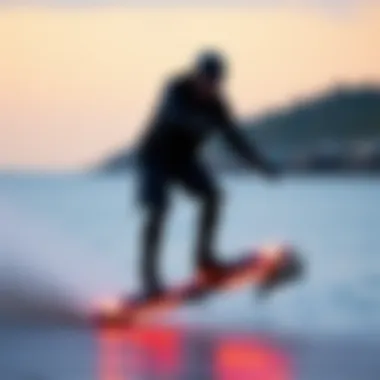
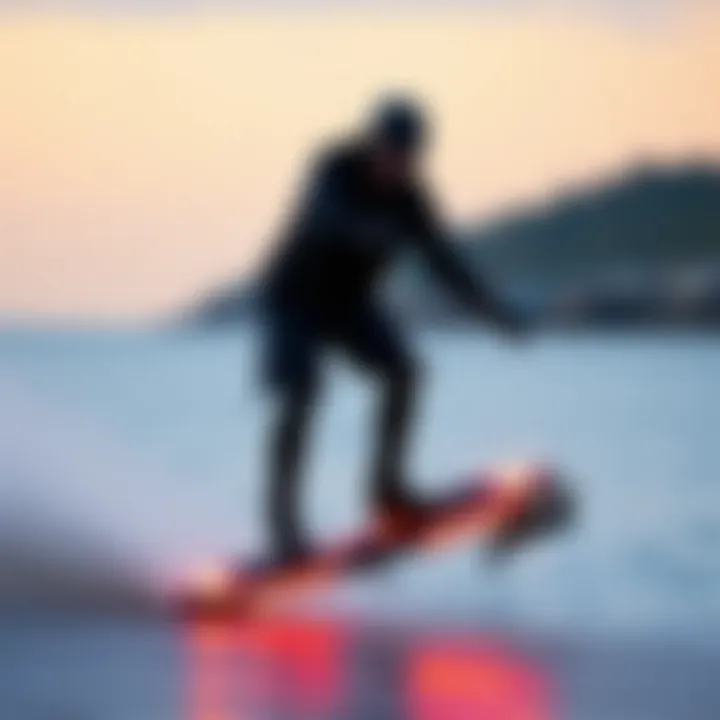
Despite these gaps, there are notable similarities in both categories. Both types emphasize rider skill, wind conditions, and equipment maintenance. Just because a board has a foil, doesn’t mean it's automatically superior; understanding how to leverage your board's design is crucial regardless of the type. It’s like choosing between a swift sports car and a sturdy truck; each has its own strengths and suitability based on your needs.
Rider Experience: Different Perspectives
The experiences of riders using hover foil boards versus traditional boards can differ just like chalk and cheese. For many traditional kiteboarders, the thrill lies in mastering tricks and stunts while being close to the water's surface. The excitement of carving through waves and experiencing the spray is a significant part of the journey. They often form a deep connection to the water and the coast.
On the other hand, hover foilers describe an immersive, almost ethereal quality to riding. Being elevated above the water offers a whole new perspective; visibility and control see a marked improvement. Many riders express feeling like they are 'flying' or 'skywalking' on the water. The sensation of weightlessness gives them a new playground for achievement.
Moreover, peer influence plays a substantial role in how riders choose between the two. As the belief grows that hover foiling is the newer, more exciting frontier, seasoned kiteboarders may feel pressure to adapt or risk being left behind. There's a sense of community in both categories, though hover foiling has recently drawn more enthusiasts thrilled by the cutting-edge technology.
"As board technology advances, so do our experiences on the water. Where one might see a physical divide, others see opportunities for collaboration and growth."
Both types of riders possess unique insights and opinions that provide a fuller understanding of the sport. While some prefer the classic approach to kiteboarding, others feel reinvigorated by the modern take of foiling. Ultimately, whether one chooses the thrill of a hover foil or the grounded reliability of traditional boards really comes down to personal preference and intended experience.
Future Trends in Hover Foiling
In the rapidly evolving world of watersports, hover foiling stands at the forefront of innovation and excitement. This section not only intends to highlight the growing popularity of hover foil boards but also seeks to uncover potential advancements that will shape their future. As kiteboarding and similar activities gain traction globally, understanding emerging trends is essential for both enthusiasts and manufacturers alike. The advancements are driven by a mix of technology, environmental awareness, and rider preferences, thus creating a pathway for transition in the watersport landscape.
Technological Innovations on the Horizon
As technology continues to progress, hover foil boards are on the cusp of remarkable improvements. One key area is in the integration of smart technology into board designs. Imagine a hover foil board equipped with sensors that can collect data on speed, agility, and rider feedback. This information could help riders tailor their experiences by adjusting performance characteristics to meet personal preferences or conditions of the water. Advances like artificial intelligence may also play a role, allowing these boards to adjust automatically for optimal performance.
"Emerging tech could level the playing field, making hover foiling accessible to a wider audience."
Another aspect to consider is the design of the foils themselves. With 3D printing gaining ground, manufacturers may offer highly customizable foils. Riders could select characteristics tailored to their body type, style, and local conditions. This level of personalization is unprecedented in the world of sports equipment.
Lastly, a focus on increased durability through innovative materials can also be expected. The use of advanced composites could lead to lighter and stronger boards that withstand the rigors of various watersports. Think of materials that not only are robust but also have a longer lifespan, reducing the need for frequent replacements.
Impact of Eco-Friendly Materials
As climate concerns take a more central role in all industries, the watersports sector is no exception. The future of hover foiling will likely see a significant shift towards sustainable practices and eco-friendly materials. Currently, many boards are constructed from materials that can harm the environment. However, forward-looking companies are exploring alternatives that not only reduce ecological footprints but also improve board performance.
Using biodegradable resins instead of traditional plastics can minimize waste and pollution. Moreover, some manufacturers are experimenting with recycled materials that retain high performance while being kinder to our planet.
Riders are increasingly conscientious about their impact on the environment, and this trend shows no signs of abating. Companies that prioritize sustainability within their production processes are likely to appeal to this environmentally aware consumer base. Thus, the integration of eco-friendly materials can be a innovative point that sets a brand apart in a competitive market.
Integration of Hover Foils in Watersports
The integration of hover foils into various watersports represents a significant evolution in both recreational and competitive realms. This technology not only enhances performance but also adds an exciting dimension to how sports are experienced on water. The rise of hover foiling is impacting multiple disciplines and reshaping conventional practices, particularly in kiteboarding, surfing, and other aquatic activities. With its unique ability to lift the rider above the water's surface, hover foiling introduces a different way to interact with the water, making it an appealing option for a broad spectrum of participants.
Versatility Across Different Watersports
Hover foils are not just a one-trick pony; they're versatile enough to complement several watersports. Here are some ways they enhance various activities:
- Kiteboarding: In this sport, hover foils allow for smoother transitions and high-speed gliding, offering kiteboarders the chance to ride in shallower waters. The ability to foil means greater exploits in varied wind conditions, keeping the fun alive even when traditional boards would struggle.
- Surfing: Surfing with a foil can transform how surfers catch waves. Riders can take advantage of smaller swells that would typically be overlooked, thus opening up more opportunities to surf when conditions seem unfavorable. This adaptability can turn a flat day into an adventurous outing.
- Wakesurfing: Wakesurfers harness foils to achieve a new level of performance behind boats. The lift generated by the foil reduces drag, allowing for smoother rides and tricks that rely on minimal contact with the water. This new layer of excitement reshapes what wakesurfing can offer.
The benefits of integrating hover foils across these disciplines include increased maneuverability and speed, but there's more. Riders can experience a feeling of liberation as they float above the water's surface, tapping into an intuitive connection with nature. This fluid motion not only adds to the exhilaration but also promotes prolonged engagement with the sport, encouraging participants to push boundaries of what they thought was possible.
The Growing Community of Hover Foil Enthusiasts
A noteworthy trend occurring alongside the rise of hover foiling is the blossoming community surrounding it. Enthusiasts are gathering in both online and offline spaces, sharing tips, tricks, and experiences. Social media platforms like Facebook and Reddit serve as gathering grounds, where riders discuss equipment, share locations, and evoke supporters.
- Online Forums: Groups dedicated to hover foiling are emerging, where members can ask questions, post videos, and offer advice on gear and techniques.
- Local Meetups: Many regions host meetups or events specifically for hover foilers, fostering camaraderie among participants. Riders from diverse backgrounds come together to exchange knowledge, from newcomers learning the ropes to veterans refining their skills.
This sense of belonging encourages continuous learning and helps to solidify a supportive environment. The community aspect is crucial because it lessens barriers for newcomers and encourages participation, which ultimately enriches the sport's landscape.
Ending: The Future of Hover Foil Boards in Kiteboarding
In the world of kiteboarding, the emergence of hover foil boards represents a significant shift, presenting fresh opportunities for riders both seasoned and novices alike. The conversation surrounding hover foiling isn’t merely about the latest trend; it’s about understanding a transformative aspect of these sports. The potential of this technology stretches beyond just novelty, promising to reshape how we approach water sports and offering profound implications in terms of performance, accessibility, and experience.
Potential for Growth and Acceptance
With the rising interest in eco-friendly practices, hover foiling could ride the wave of sustainability in a manner rarely seen before in watersports. Unlike traditional methods, which typically relied on substantial energy and resources, the hover foil board operates with greater efficiency. This can naturally appeal not only to competitive athletes but also to casual users who are starting to appreciate the finer details of performance against the backdrop of environmental consciousness.
Furthermore, as manufacturers innovate and refine their offerings, increased availability and affordability are likely. Brands such as Naish and Fanatic are consistently pushing boundaries with designs that cater to a wider range of skill levels. The more varied the options out there, the more likely acceptance will grow in diverse communities.
- Community Engagement: Local kiteboarding groups are starting to embrace hover foils, hosting events that showcase the new technology. This grassroots enthusiasm can spark broader interest.
- Instruction and Education: As professionals create workshops around the unique techniques of hover foiling, even those who are skeptical will have a chance to explore the potential benefits firsthand.
With the right momentum, hover foiling could transform into a staple in watersports culture, not just among elite kiteboarders but among the everyday adventurers who seek thrills without limits.
Final Thoughts on Adoption by Riders
The adoption of hover foil boards brings with it an array of considerations that ought to be addressed. First off, an open-minded approach to learning is essential. Riders must understand that transitioning to hover foiling involves more than simply swapping out boards. It requires a recalibration of skills and techniques, embracing a fresh way of riding that may feel foreign initially but promises to be rewarding.
The advantages of stability and maneuverability can greatly enhance the kiteboarding experience, especially during lighter wind conditions when traditional boards might struggle. As riders share their experiences, whether on platforms like Reddit or with friends at the beach, a gradual shift in mindset will undoubtedly occur. They’ll see that with the right instruction and practice, the learning curve can lead to significant enjoyment.
- Personal Stories: Early adopters are already sharing success stories, emphasizing the thrill found in mastering this new skillset. Their narratives boast not just about faster speeds or higher jumps, but about the sheer joy of ‘flying’ above the water.
- Social Media Influence: Influencers in the kiteboarding arena are showcasing the freedom and creativity that hover foiling permits. Their visual storytelling acts as both education and motivation, urging others to experiment with the technology.
